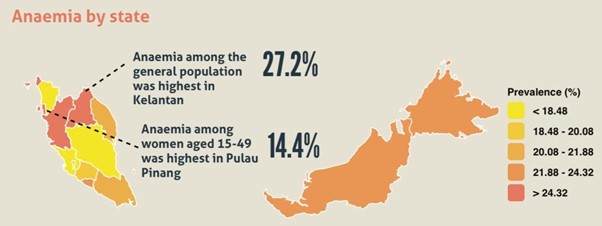Dr. Chang Shi Ya, Dr. Sharifah Azdiana Binti Tuan Din
Jabatan Perubatan Klinikal, Institut Perubatan dan Pergigian Termaju, USM
Anaemia is a condition when someone has insufficient healthy red blood cells to transport oxygen throughout the body. The optimal hemoglobin concentration required to meet physiologic needs varies by age, gender, elevation of residence, smoking habits, and pregnancy status. (1)
Anaemia is a serious global public health problem that particularly affects young children, menstrual adolescent girls and women, and pregnant and postpartum women (1). According to the Malaysia National Health Morbidity Survey 2019, approximately 20% of Malaysians had anaemia (Figure 1). higher frequency among women with reproductive age, with 3 out of 10 anaemic. It is comparable to hypertension prevalence up to 30% and greater than diabetes mellitus, with a prevalence of 18.3% (2).
Iron deficiency is the most common nutritional deficiency that causes anaemia. Iron deficiency can occur as a result of (i) insufficient dietary iron intake, such as vegan diet restrictions or a lack of iron-rich foods; (ii) excessive iron loss, such as internal bleeding, haemorrhage associated with childbirth, or menstrual loss; (iii) impaired iron absorption; (iv) low iron stores at birth; and (v) nutrient interactions affecting iron bioavailability (3).
If you are experiencing these symptoms, it is important to talk to your doctor.
Why is it dangerous? It can cause serious problems for the heart (2). It also has an impact on school performance due to developmental delays and behavioral disturbances such as decreased motor activity, social interaction, attention to tasks, productivity in adult life, and overall quality of life. Anaemia during pregnancy has been linked to poor maternal and birth outcomes, such as early birth and low birth weight.
Iron-deficiency Anaemia may be avoidable if causes of blood loss or problems with iron absorption that can lead to the condition are treated. Maintaining a balanced diet rich in iron and vitamin C will help the body maintain iron levels.
a) Good sources of iron. Iron is primarily stored in the red blood cells. The majority of the iron is recycled from broken-down red blood cells, with the recommended intake for an adult being 8 mg/day, while premenopausal women are recommended a daily intake of 18 mg (4) to meet the daily requirement of 1-3mg/day. (5) The type of iron consumed can influence iron adsorption. Iron is classified into two types:heme and non-heme (Figure 3). Heme iron can be found in meat, shellfish, and eggs. This iron is more easily absorbed by the human body, up to around 30% of total dietary consumption. Plant-based foods, on the other hand, such as vegetables, fruits, and nuts, are high in non-heme iron. Only around 10% of non-heme iron is readily absorbed by the human body, and this can be enhanced by eating vitamin C-rich foods such as citrus fruits, peppers, and tomatoes (6).
b) Vitamin C-rich foods such as oranges, strawberries, and tomatoes help boost iron absorption. (4-6)
c) Avoid dietary restrictions that diminish iron availability.
Calcium is a well-known inhibitor of iron absorption; consequently, dairy products such as milk or calcium supplements should be consumed at a different time than the main meals (7). Tannins, found in tea and coffee, are another inhibitor of iron absorption. As a result, they should be avoided in conjunction with iron-rich foods as well. Various timing recommendations have been offered, such as avoiding foods that reduce iron absorption for at least 2 hours prior to or after a main meal that should consist of iron-rich food. (7)
If you’ve been advised to take iron supplements, they should be taken on an empty stomach (at least an hour prior to a meal) and best taken with a vitamin C-rich drink like orange juice. Keep in mind that dark-colored or black stools are common side effects of oral iron supplements. If you are unable to tolerate nausea, vomiting, constipation, or diarrhea as a result of the side effects of oral iron supplements, consult your doctor.
References
1. Anaemia, World Health Organization. Available at: https://www.who.int/news-room/factsheets/detail/anaemia#:~:text=Iron%20deficiency%2C%20primarily%20due%20to,haemoglobin%20and%2F or%20erythrocyte%20production. (Accessed: 17 November 2023).
2. Healthcare Demand - Institute for Public Health. Available at:
https://iku.gov.my/images/IKU/Document/REPORT/NHMS2019/Fact_Sheet_NHMS_2019-English.pdf (Accessed: 18 November 2023).
3. Iron deficiency (no date) Maltofer NZ. Available at: https://maltofer.co.nz/iron-deficiency/ (Accessed: 17 November 2023).
4. The Blood Safety and Conservation Team. Taking Iron Supplements: Information for Patients. Oxford University Hospitals, NHS Trust [Internet]. 2015 [cited 2023 Aug 13]. Available from: https://www.ouh.nhs.uk/patient-guide/leaflets/files/11903Piron.pdf
5. Hoffbrand, A.V. and Steensma, D.P. (2020) Hoffbrand’s essential haematology. Chichester: Wiley Blackwell.
6. Baart AM, Van Den Hurk K, De Kort WL. Minimum donation intervals should be reconsidered to decrease low hemoglobin deferral in whole blood donors: an observational study. Transfusion. 2015 Nov;55(11):2641-4.
7. Milman, N.T. (2020) A review of nutrients and compounds, which promote or inhibit intestinal iron absorption: Making a platform for dietary measures that can reduce iron uptake in patients with genetic haemochromatosis, Journal of nutrition and metabolism. Available at:
https://www.ncbi.nlm.nih.gov/pmc/articles/PMC7509542/ (Accessed: 27 November 2023).
8. Department of Health & Human Services (2003) Iron and iron deficiency, Better Health Channel. Available at: https://www.betterhealth.vic.gov.au/health/conditionsandtreatments/iron (Accessed: 27 November 2023).






